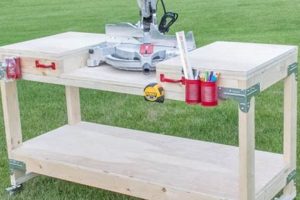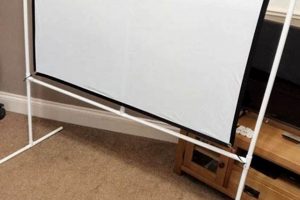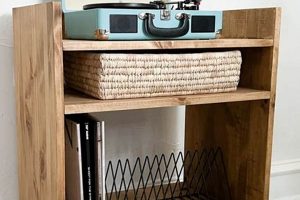Constructing a support structure for a guitar using wooden materials and a do-it-yourself approach involves designing and building a stand at home. This project typically utilizes lumber, woodworking tools, and a set of plans or instructions to create a functional and aesthetically pleasing fixture for holding a guitar when it is not being played. An example is fashioning a simple A-frame stand from pine boards, held together with screws and finished with a protective sealant.
This activity provides several advantages, including cost savings compared to purchasing a manufactured stand and the opportunity to customize the design to specific needs and preferences. Furthermore, it offers a practical application of woodworking skills, potentially leading to increased proficiency and a sense of accomplishment. The practice of crafting instrument supports dates back to the early days of stringed instruments, though modern designs prioritize stability and portability.
Subsequent sections will delve into specific design considerations, material selection, step-by-step construction techniques, and finishing options relevant to the successful completion of a handcrafted guitar support.
Essential Considerations for Wooden Guitar Support Construction
The following points offer guidance for individuals embarking on the creation of a wooden fixture to hold a guitar, emphasizing both structural integrity and aesthetic appeal.
Tip 1: Material Selection: Opt for hardwoods such as maple or oak for enhanced durability and resistance to wear. Softwoods, like pine, are more cost-effective but require careful consideration of load-bearing capacity and potential for damage.
Tip 2: Design Stability: Prioritize a design that provides a low center of gravity and a wide base of support to prevent accidental tipping. Angled legs and a secure cradle are crucial elements.
Tip 3: Precise Measurements: Ensure accurate measurements of the guitars body dimensions to create a snug yet non-restrictive cradle. Account for variations in guitar sizes if the stand is intended for multiple instruments.
Tip 4: Secure Joinery: Employ strong joinery techniques, such as mortise and tenon or dovetail joints, to maximize structural integrity. Screws and glue should be used in conjunction for added strength.
Tip 5: Protective Padding: Apply soft padding, such as felt or foam, to all surfaces that come into contact with the guitar’s finish. This prevents scratches and marring of the instrument.
Tip 6: Smooth Finishing: Sand all surfaces thoroughly to eliminate sharp edges and splinters. Apply a durable finish, such as varnish or lacquer, to protect the wood and enhance its appearance.
Tip 7: Weight Distribution: Analyze the weight distribution of the guitar to ensure the support points are adequately reinforced. Reinforcements may be necessary for the neck support area.
Adherence to these guidelines will result in a secure and attractive support for valuable musical instruments.
The subsequent section addresses design variations and aesthetic considerations for a personalized wooden guitar support.
1. Wood Selection
Wood selection exerts a primary influence on the overall quality and longevity of a guitar support fashioned through do-it-yourself methods. The type of wood chosen directly impacts the structural integrity, aesthetic appeal, and resilience of the finished piece. Hardwoods, such as maple, oak, or walnut, offer superior strength and resistance to wear, thereby creating a more stable and durable stand. Conversely, softwoods like pine or fir, while more economical, may require additional reinforcement to adequately support the weight of a guitar and are more susceptible to dents and scratches. The selection process, therefore, becomes a critical initial step in the construction process.
Consider the example of a stand intended for a heavy electric guitar. Constructing it from a softwood, without strategic reinforcement, could lead to structural failure over time, potentially resulting in damage to the instrument. Alternatively, a stand crafted from hardwood may withstand considerable weight and usage, preserving both its functionality and appearance for an extended duration. The finish quality is also affected; hardwoods typically accept stains and finishes more uniformly than softwoods, resulting in a superior aesthetic outcome. The availability and cost of different wood types in a particular geographic region often drive the choice, thus balancing structural requirements with budgetary constraints is a practical necessity.
In summary, wood selection forms a crucial link in the success of a guitar support building project. The inherent properties of the chosen material directly influence the stand’s durability, stability, and visual appeal. A careful and informed decision regarding wood type, taking into account factors such as guitar weight, desired aesthetic, and budgetary limits, is paramount for achieving a functional and aesthetically pleasing final product.
2. Design Stability
Design stability is a paramount consideration in the context of creating guitar supports via do-it-yourself methods using wood. A structurally sound design mitigates the risk of accidental tipping or collapse, thus safeguarding the instrument. Its role is to ensure the fixture securely holds the guitar in various environmental conditions and prevents damage resulting from instability.
- Base Width and Center of Gravity
A wider base provides increased stability by lowering the center of gravity. This prevents the stand from easily tipping over if bumped or subjected to uneven surfaces. For instance, a stand with a narrow base and a high center of gravity is prone to instability, especially when holding a heavier guitar, which requires careful considerations.
- Leg Angle and Support Structure
The angle at which the legs are positioned relative to the central support significantly impacts overall stability. A wider leg splay increases the footprint of the stand, creating a more robust foundation. Internal support structures, such as cross braces, further enhance rigidity and prevent wobbling. The angles and support structure impact the overall stability of guitar stand wood diy.
- Cradle Design and Instrument Fit
The cradle, the part that directly supports the guitar’s body, must be designed to securely hold the instrument without causing damage. A properly contoured cradle distributes the weight evenly and prevents slippage. Insufficient cradle depth or improper contouring contributes to instability.
- Material Strength and Joint Integrity
The choice of wood and the method of joining the components are critical for maintaining long-term stability. Weak wood or poorly executed joints compromise the structural integrity of the stand, increasing the risk of failure. Hardwoods and robust joinery techniques are essential.
Collectively, these facets of design stability directly determine the safety and reliability of a guitar stand constructed from wood. Neglecting any of these considerations compromises the stand’s ability to protect the instrument and undermines the value of the do-it-yourself endeavor. Therefore, meticulous attention to these aspects is crucial for a successful project.
3. Accurate Measurements
The relationship between precise dimensional analysis and the construction of wooden guitar supports is causal. Imprecise measurements invariably lead to a flawed product, potentially compromising the guitar’s safety and the stand’s functionality. Accurate measurements serve as the foundational element upon which the structural integrity and stability of the stand are built. For example, if the cradle is too narrow due to inaccurate measurements, it will fail to properly secure the guitar. Conversely, an overly wide cradle will not provide adequate support, increasing the risk of the instrument tipping. The success of the endeavor hinges upon the meticulous application of dimensional accuracy.
Practical application demands the utilization of calibrated measuring instruments and adherence to established woodworking principles. Consider the design phase; each component’s dimensions and angles must be accurately determined to ensure proper fit and load distribution. The legs, for instance, must be precisely cut to the specified length and angle to provide a stable base. Further, the points where the guitar will contact the stand must be precisely measured and padded to avoid damage to the instrument’s finish. Failing to correctly measure and account for the thickness of padding material, for instance, can result in a cradle that is either too tight or too loose, diminishing its effectiveness.
In conclusion, accurate measurements are not merely a detail but a fundamental prerequisite for the successful construction of a secure and functional guitar support from wood. The consequences of neglecting this aspect range from cosmetic imperfections to catastrophic failure, jeopardizing the instrument’s safety. Careful attention to measurement accuracy during all phases of the project, from initial design to final assembly, represents a critical determinant of the project’s overall success and guarantees its longevity.
4. Secure Joinery
The creation of a durable and reliable wooden guitar support hinges significantly on the implementation of secure joinery techniques. The integrity of the joints directly influences the stand’s ability to withstand the weight and pressure exerted by the guitar, ensuring it remains stable and prevents accidental falls. A poorly constructed joint represents a critical point of potential failure, rendering the entire structure unreliable. For instance, a simple butt joint, relying solely on adhesive, may prove insufficient for load-bearing elements, leading to joint separation and structural collapse over time. The practical implication is that the selection and execution of joinery methods are fundamental to the successful realization of a long-lasting and trustworthy guitar support.
Employing more robust techniques, such as mortise and tenon, dovetail, or half-lap joints, offers enhanced structural stability. These methods, often combined with adhesives and mechanical fasteners, create a stronger bond between the wood components, distributing the load more effectively and minimizing stress points. The selection of a specific joint type should correlate with the intended stress and load requirements of that specific connection point. For example, joints securing the base of the stand to the upright supports should utilize a more substantial joinery method than those used for purely decorative elements. The proper execution of these joinery techniques requires precision, skill, and the appropriate woodworking tools, making it a crucial aspect of the overall project.
In conclusion, secure joinery is not merely a construction detail but a fundamental prerequisite for a successful wooden guitar support. Its direct impact on the structural integrity and long-term reliability of the stand cannot be overstated. The careful selection and precise execution of appropriate joinery methods are essential for safeguarding valuable musical instruments and ensuring the stand’s longevity. This focus on secure connections is paramount for any individual undertaking the crafting of a guitar support using woodworking techniques.
5. Protective Padding
Protective padding constitutes an essential element in the construction of wooden guitar supports. Its integration mitigates potential damage to the instrument’s finish, preventing scratches, dents, and chemical reactions between the guitar’s surface and the wood or other materials used in the stand’s construction. Its role extends beyond mere aesthetics, preserving the instrument’s value and structural integrity. A successful implementation directly contributes to the longevity and usability of both the stand and the guitar.
- Material Selection
The selection of appropriate padding materials is critical. Felt, cork, and specialized foam products with inert chemical properties are commonly employed. Materials must be non-abrasive, chemically stable, and of sufficient density to provide cushioning without compressing excessively. The inappropriate selection, such as the use of materials containing sulfur compounds, could lead to discoloration or degradation of the guitar’s finish.
- Placement and Coverage
Optimal placement involves strategic positioning of padding at all points of contact between the guitar and the stand. This includes the cradle supporting the body, the neck rest, and any other areas where the instrument may rub against the wood. Incomplete coverage leaves vulnerable areas exposed, negating the protective benefits. Consistent and thorough application is therefore paramount.
- Adhesive Application
The method of affixing the padding to the wooden structure is crucial. Non-reactive adhesives, specifically designed for bonding dissimilar materials, should be employed. Improper adhesive selection, such as the use of cyanoacrylate (super glue) on certain finishes, may result in irreversible damage. The application should be even and controlled to prevent seepage or uneven bonding, both of which can compromise the padding’s effectiveness.
- Maintenance and Replacement
Protective padding is subject to wear and degradation over time. Regular inspection is necessary to identify signs of compression, tearing, or chemical breakdown. Replacement of worn or damaged padding is essential to maintain the protective function. Neglecting this maintenance aspect can lead to gradual erosion of the padding’s protective qualities, ultimately exposing the instrument to potential harm.
Collectively, these factors underscore the importance of protective padding in the context of crafting a wooden guitar support. Its careful selection, precise placement, secure adhesion, and ongoing maintenance are all crucial determinants of its effectiveness in safeguarding valuable musical instruments. A comprehensive approach to these elements ensures both the aesthetic preservation and the structural integrity of the instrument are maintained over its lifespan.
6. Smooth Finishing
The application of smooth finishing techniques to a wooden guitar support created via do-it-yourself methods transcends mere aesthetics. It represents a critical step in ensuring both the protection of the instrument and the longevity of the support itself. The absence of a proper finish can lead to detrimental effects, impacting both the object’s appearance and functionality.
- Surface Preparation
Prior to applying any finish, meticulous surface preparation is essential. This involves thorough sanding to eliminate imperfections, splinters, and sharp edges. Inadequate preparation results in an uneven finish, highlighting rather than concealing flaws. For instance, failure to properly sand before applying varnish will trap dust particles, creating a textured, rather than smooth, surface. This also applies to guitar stand wood diy, ensure wood texture and roughness is appropriate for painting.
- Sealant Application
A sealant serves as a protective barrier, preventing moisture absorption and minimizing the risk of wood warping or cracking. It also prepares the surface for subsequent coats of finish, ensuring uniform adhesion. Without a sealant, the wood may absorb excessive amounts of the finish, leading to discoloration or uneven gloss. A common example is the application of a polyurethane sealant before applying a lacquer topcoat for guitar stand wood diy.
- Finish Selection
The choice of finish significantly impacts the final appearance and durability of the guitar support. Options range from varnish and lacquer to oil-based finishes, each offering varying degrees of protection and aesthetic qualities. Selecting an inappropriate finish can compromise the wood’s integrity or react negatively with the guitar’s finish. For instance, using a water-based finish on a stand constructed from a water-sensitive wood without proper sealing can lead to swelling and distortion.
- Application Technique
Proper application techniques are crucial for achieving a smooth and consistent finish. This involves applying thin, even coats and allowing sufficient drying time between applications. Over-application can lead to runs, drips, and an uneven surface. Conversely, insufficient application results in inadequate protection and a lackluster appearance. Many guitar stand wood diy tutorials will show that spraying creates the most consistent coat compared to manual application.
In summary, smooth finishing is an integral component of crafting a successful wooden guitar support. The combination of meticulous surface preparation, appropriate sealant application, judicious finish selection, and skillful application techniques ensures both the aesthetic appeal and the long-term protection of the instrument it holds.
Frequently Asked Questions
The following section addresses common inquiries regarding the design, construction, and maintenance of guitar supports crafted from wood, providing detailed information for individuals undertaking such projects.
Question 1: What type of wood is most suitable for building a guitar stand?
Hardwoods, such as maple, oak, or walnut, are generally preferred due to their superior strength and durability. Softwoods, like pine, can be used but may require additional reinforcement to adequately support the guitar’s weight and resist wear.
Question 2: How can the design of a wooden guitar support ensure stability and prevent tipping?
A wide base, low center of gravity, and properly angled legs contribute significantly to stability. Employing a secure cradle design that conforms to the guitar’s body shape further minimizes the risk of accidental tipping.
Question 3: What joinery methods are recommended for constructing a strong and reliable guitar stand?
Mortise and tenon, dovetail, and half-lap joints offer superior strength compared to simple butt joints. Combining these techniques with adhesive and mechanical fasteners enhances the structural integrity of the stand.
Question 4: How should the guitar’s finish be protected from damage when using a wooden stand?
Applying soft padding, such as felt or foam, to all contact points between the guitar and the stand is crucial. Select materials that are chemically inert and non-abrasive to prevent discoloration or scratching of the instrument’s finish.
Question 5: What type of finish is best for protecting a wooden guitar stand from moisture and wear?
Varnish, lacquer, and polyurethane finishes provide a durable protective layer against moisture, scratches, and UV damage. Ensure the finish is compatible with the type of wood used and apply multiple thin coats for optimal protection.
Question 6: How often should a wooden guitar stand be inspected and maintained?
Regular inspections are recommended to check for loose joints, worn padding, or damage to the finish. Tighten any loose connections, replace worn padding, and reapply the finish as needed to maintain the stand’s structural integrity and protective qualities.
In summary, the successful construction of a wooden guitar support hinges on careful material selection, stable design, secure joinery, protective padding, and a durable finish. Regular maintenance ensures the stand continues to provide reliable support and protection for the instrument.
The subsequent section will address design variations and aesthetic considerations for customized wooden guitar supports.
Conclusion
This exploration of guitar stand wood diy has illuminated critical facets of the construction process, encompassing wood selection, design stability, accurate measurements, secure joinery, protective padding, and smooth finishing. Each element contributes directly to the structural integrity, functional efficacy, and aesthetic appeal of the finished product. Thorough consideration of these factors is paramount for achieving a successful outcome.
The principles outlined represent a foundation for individuals embarking on the construction of a handcrafted guitar support. Adherence to these guidelines enhances the likelihood of creating a stable, durable, and protective fixture for valuable musical instruments. Continued application of these techniques will contribute to the ongoing tradition of craftsmanship and instrument preservation.







